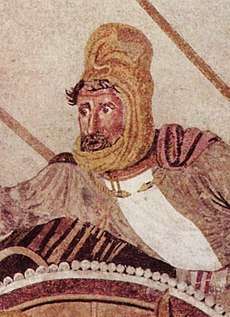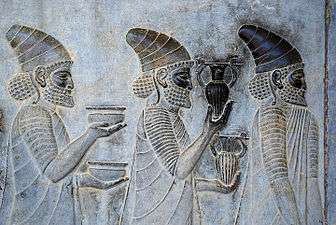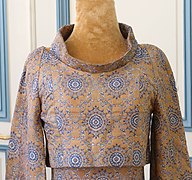Persian clothing
Traditional Persian clothing can be seen in Persian miniature paintings, employ both vivid and muted colors for clothing, although the colors of paint pigment often do not match the colors of dyes.
The clothing of ancient Iran took an advanced form, and the fabric and color of clothing became very important at that time.[1] Depending on the social status, eminence, climate of the region and the season, Persian clothing during the Achaemenian period took various forms. The philosophy used in Persian clothing, in addition to being functional, also had an aesthetic role.[1]
Traditional Persian clothing, although not worn in urban areas, has been well preserved in texts and paintings throughout history.
Men's dress
The traditional men's garment included the Shalvar, and Jameh combination, often with a wide belt called Kamarband, from which English gets the word "cummerbund".
Headdresses were also worn by men in traditional wear, known as the Sarband. Long robes and loin cloths were also worn by the women and men in Persia. They often used gold jewelry.
Gallery
 Darius III of Persia.
Darius III of Persia.- stairs of the Apadana
 Detail of a relief of the eastern stairs of the Apadana at Persepolis
Detail of a relief of the eastern stairs of the Apadana at Persepolis A possible imitation of Persian clothing. (Two-piece)
A possible imitation of Persian clothing. (Two-piece)
 Modern shape of women's Persian clothing.
Modern shape of women's Persian clothing.
References
- Ancient Egyptian, Mesopotamian & Persian Costume (Dover Fashion and Costumes) – November 2, 2011
- پوشاک در ایران باستان، فریدون پوربهمن /ت: هاجر ضیاء سیکارودی
- Iran: 5000 Years of Clothing, Jewellery and Cosmetics - ISBN 978-0980971446
- پوشاک در ایران باستان، فریدون پوربهمن/ت: هاجر ضیاء سیکارودی، امیرکبیر. 2007. pp. 24, 25, 57.
External links
| Wikimedia Commons has media related to Clothing of Iran. |